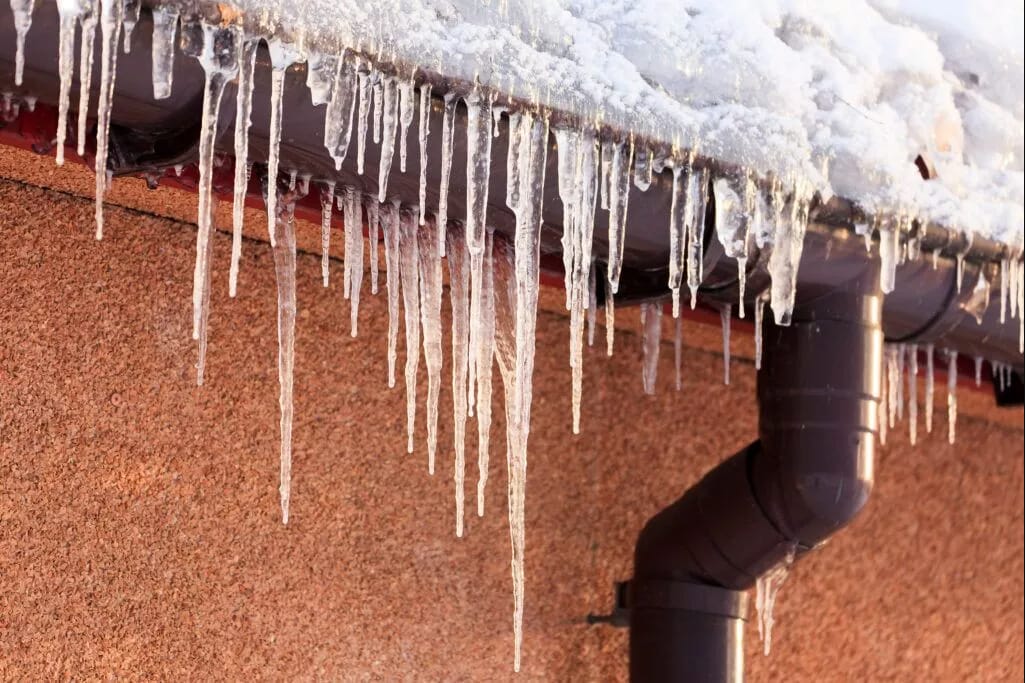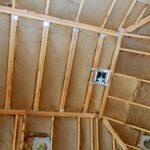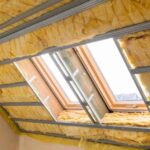People have been building their homes for countless generations to protect themselves and their families from the elements. Our homes protect us from weather changes, from wind to rain, sleet, and even the sun’s harsh rays.
They give us warmth in the winter and shade in the summertime. Out of all the architectural components of a house, roofs bear the responsibility of being the first line of defense. The roof protects our home from winter winds and heavy snowfall, but it can’t do it alone.
Heavy snowfall and poor drainage are at the intersection of what you want to avoid when it comes to maintaining the health of your home. Unpredictable weather conditions can cause severe damage in a short amount of time, especially when something goes wrong with your drainage system. From worst to most manageable, here are some ways poor drainage can affect your roof after a snowstorm.
Complete roof failure for flat roofs
Snow is very heavy, especially wet snow found at the end of winter and early spring. Without adequate drainage, snow can create stress on areas of your roof. Large commercial buildings and different architectural styles of businesses and even residential homes incorporate flat roofs into their design.
Standing water usually reaches the lowest point on a flat roof. Scuppers are drains located at the center of that low point and divert water to external gutters. These can become clogged if you don’t remove the snow.
Heavy snow puts too much stress on a flat roof, resulting in damage.
- Broken trusses and joists: the wooden structure of a flat roof might become warped or even snap.
- Leaks: As strain from above takes roofing materials to their limit, cracks in tar and tar paper and underlayment can form.
- Sagging: The weight of the snow can cause gradual sagging, leading to water damage inside after a time
- Total roof structure failure: Flat roofs can collapse if measures aren’t taken to remove snowfall
- Roof failure in sloped roofs isn’t as problematic, but it does happen, especially with heavy snowfall and a lack of regular maintenance.
- Collapsed roofs can lead to property damage and even injury or death!
Damage to shingles
On a peaked roof, too much snow can result in damage due to frost action. When the snow melts and sticks to shingles, it can freeze, thaw, and refreeze. The hydraulic forces of frost action during the expansion of melted water turning to ice can cause damage to shingles, tar paper, and even flashing.
Asphalt-type shingles can become brittle when frozen, and high winds or other pressure (such as walking on the shingles) can break them. Properly insulated homes provide enough ambient heat to melt snow from rooftops.
Too much insulation can cause deep accumulation. Have your attic inspected for proper insulation levels yearly before the white stuff starts to fly.
Damage to gutters
During snow storms, lots of snow can add weight to gutters. The formation of ice dams makes this even worse.
When the snow melts, it has nowhere to go, and overflows can occur, leading to backflow underneath shingles, fascia, and even siding as water travels outside controlled drainage areas. Water collecting behind the siding and running back into the eaves can cause many problems.
Moisture can warp the fascia boards, seep back into the exterior wall board, and even reach the home’s interior. Pooling water can reveal itself as the melting snow saturates insulation and drywall and even runs down interior walls.
Mold
Standing water is a perfect habitat for the growth of mold and fungus. Even in the winter months, despite the temperatures and relatively dry air, inside your home conditions are perfect for mold colonies to grow.
Mold needs moisture and organic material to thrive. It uses standing water and damp places to spread as well as reproduce. It feeds on organic materials such as cellulose insulation, wood, drywall paper, and furniture. Mold creates spores that are toxic to people and animals.
The presence of mold can lead to allergic reactions, bad odors, advanced decay of organic materials, and stains. If you notice leaks, act quickly. Remove standing water and provide lots of ventilation. Clean moldy areas with a bleach solution and remove damaged material containing spores.
Icicles caused by poor roof drainage

Poor drainage might make your home look like a charming holiday painting, but the icicles hanging from your gutters are a sign of something you don’t want. Aside from the problems caused by the ice dams mentioned above, icicles can cause injury and damage to property when they break loose from your roof.
The frost action of icicles can break your gutters loose and require expensive repairs and replacement. Safely break icicles away from gutters at a safe distance, preferably with a long pole or other means. Take care not to damage gutters or windows in the process.
Roof leaks
Snow storms have a good way of revealing the leaks that have formed over the lifespan of your roof. As the snow melts, it seeps into your roof’s little fissures and holes, and the water works its way into your home.
Remove the snow from your roof if you suspect roof damage from previous seasons, such as hailstones, wind, heavy rains, or impacts. Roofing inspections after significant events can go a long way to preventing leaks and reducing potential damage to your roof.
Yard damage
When the snow melts, your gutter system is useful in redirecting the water out and away from your home. Damaged or blocked gutters can’t properly move this water, leading to a lot of running water flooding different areas of your yard which aren’t meant to take that kind of runoff.
This can result in holes being bored into your yard with hydraulic force and saturation in other areas. Some soil conditions can result in ground shifts, sinkholes, and other erosion.
Unclogging gutters of leaves and other debris and ensuring you have enough downspouts for your drainage area are important preventative measures.
Damage to foundation
When water isn’t directed away from your home properly, this can result in saturation of the ground around your foundation. Over time, concrete may spill or soften, leading to leaks and cracks.
Eventually, this damage to your foundation will pass the point of being able to repair it. It might even allow for cracks and fissures that permit radon gas to enter your home from the surrounding earth.
Contact the experts
The effects of poor roof drainage are far-reaching and, at the very least, an expensive problem to fix. Eventually, poor drainage can result in disastrous consequences that are beyond repair.
Regular roofing inspections offer a solution to this problem, and a good roofing contractor can work with you for repairs and replacement if needed. Snow and ice can wreak havoc on your home if they aren’t kept in check, which is why you should contact us if you suspect problems after recent heavy snowfall.
Our roofing experts offer knowledgeable and timely service year-round. We’ve got you covered, whether it is slope roofs, roof repairs, drains, or replacement. Extending the life of your roof can protect your home for generations to come. Whether it is the winter season, summer, or Spring and Fall, proper drainage goes a long way to ensuring a safe and secure home.






